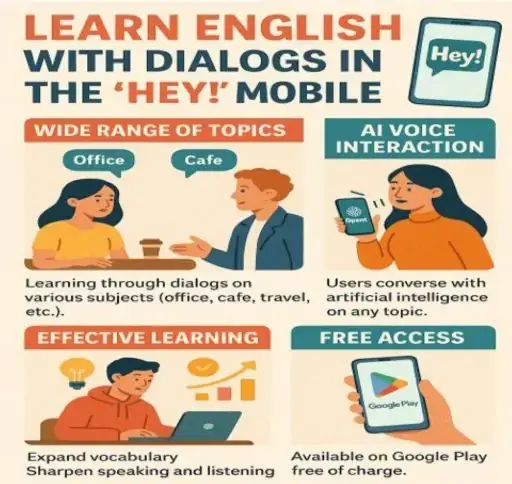Language Mobile Application “Hey!” —Development, Possibilities, and Future
The article presents the development history of the new mobile application “Hey!”. Designed for learning English and facilitating user adaptation to an English-speaking environment. The project was created by Yaroslav Golendukhin and Saveliy Varlamov, students of BEST Gymnasium (Petropavlovsk, Kazakhstan). Further, describes in detail the key stages of development. From analyzing existing solutions and identifying the target audience to designing the functionality and technical features of the product. The project was supervised by English language teachers Yuliya Starchekova and Yuliya Dmitrieva from the same gymnasium.
The mobile application is based on modern learning methodologies, leverages artificial intelligence, and offers personalized learning scenarios. It features flashcard modules, interactive dialogues, and a free communication mode. The target audience research made it possible to tailor the product to meet the current needs of users across various age groups and professional backgrounds. “Hey!” targets learners with at least an A2 level of English proficiency and supports their progress toward confident language use in real-life situations.
Defining the Target Audience for the “Hey!” App
English is one of the most widely spoken languages in the world today. Approximately 1.5 billion people speak it, and about 1 billion are actively studying it. English has penetrated all spheres of life: science, mass media, education, work, and leisure.
During the implementation of our project, we asked ourselves: “For whom will our software product be created? How can we motivate people studying English to use the Hey! application?” To clarify this issue, we developed a questionnaire and conducted a survey of potential users, like schoolchildren, students, and older people.
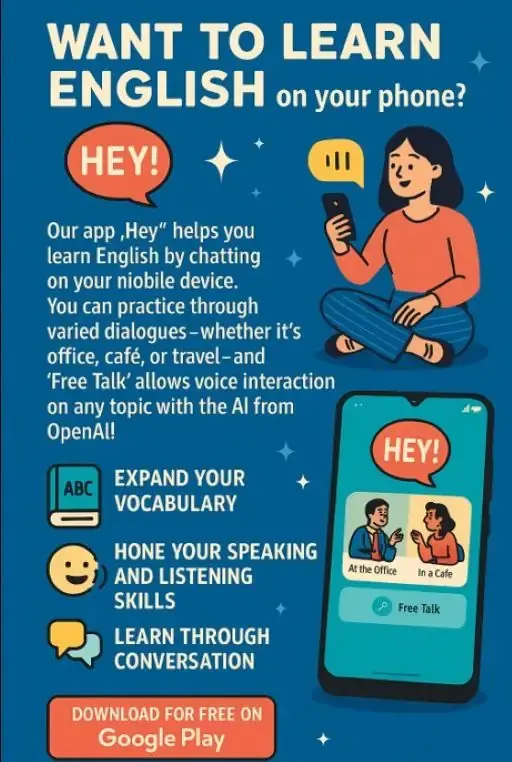
Here is the result.
After analyzing the survey results, the structure of the target audience of the “Hey!”
The application was identified.
- Age groups: teenagers (13-18 years), young adults (19-30 years), adults (31-50 years).
- User profile: students, professionals (managers, engineers, programmers, etc.), travelers, emigrants.
- Motivation: career growth, emigration, exam preparation, improving English communication skills, and personal growth.
- Difficulties: lack of time and discipline, fear of communication, lack of practice, and feedback.
Target segments have the following characteristics:
- Teens: prone to learning through gamification, interested in interaction with AI.
- Adults under 30: value mobility, efficiency, and adaptive scenarios.
- Adults over 30: strive for professional language practice and practical application of the language.
Most respondents aim to reach the B2 ( Upper-Intermediate ) or C1 (Advanced) level, starting from A2 ( Elementary ). This confirms the appropriateness of focusing the Hey! application on the intermediate and high levels of English proficiency. At the same time, many (more than 42% of respondents) wanted to learn the language, taking into account local language features. With this in mind, the main idea when planning the application was that a person memorizes. And begins to use a foreign language much faster if he finds himself in typical social situations, as if he were already in an English-speaking country. Therefore, it was actively planned to include local dialects and pronunciation accents, and idiomatic expressions in the dialogues.
Research on Educational Applications: Their Advantages and Disadvantages
We started working on our project by analyzing the methods used in various mobile applications for learning English. In the process of familiarization, we looked at many digital tools. Each of them has its specialization, accordingly focusing on a certain target audience.
Of course, we did not use all of the methods in the product we developed, “Hey!”. But, in our opinion, we selected the most effective ones from a diverse set of options, focusing on our target audience. Let’s organize the information we received about existing language applications.
The wishes of the target audience largely shape the specializations of educational digital products. Developers design some of these products strictly for children, such as ADC Kids, Fun English, Study Cat, and Lingokids. Others – to learn the language through dialogue with a native speaker ( HelloTalk , Speaky , Tandem ). Also, others – to expand vocabulary ( Memrise , Puzzle English , WordUp ). Additionally, others, to maximally improve the grammar of the language ( Duolingo, Polyglot-16, English Galaxy ). We have indicated only the most notable of the directions. There are still many quite specific applications with a narrow target group.
At the beginning of the project, we faced a rather difficult but interesting task. To evaluate the teaching methods used in the above products and select several of the strongest teaching options.
Here is a brief description of the digital tools that seemed most interesting to us:
- One of the most popular apps for learning English is Duolingo: It has been downloaded over 100 million times on Google Play alone (Duolingo Guides 2024). And it’s no wonder: the learning is based on simple exercises and mini-games, and the interface is bright and friendly. As a result, you can easily expand your vocabulary, learn to use new words in speech, and improve your listening comprehension.
- Memrise: Another tool for memorizing words and expressions (MakeUseOf 2024). The principle of operation is simple: you set a goal for the number of words you want to learn each day, and then do game exercises. Everything is organized easily, excitingly, and without unnecessary details.
- You’ve probably heard more than once that the best way to improve your knowledge of a language is to communicate with native speakers. HelloTalk App (HelloTalk 2024) was created exactly for this purpose.
- Busuu: Offers not just exercises, but full-fledged mini-courses created by professional teachers (Busuu 2024). You will be able to develop all skills: reading, writing, speaking, and listening. And most importantly, no complex formulations from textbooks, everything is based on examples from real conversational speech.
- LinguaLeo: One of the first applications for simple and interactive learning of English, existing since 2010 (LinguaLeo 2024). It constantly improves its mechanics and can now adapt to your level. There are many options for studying: you can create your dictionary, improve your grammar, and even participate in battles (mini-competitions) with other users.
Additional Tools
- Rosetta Stone: You can use the original mechanics of memorizing words through associations (Rosetta Stone 2024). In addition, the application offers trainers for improving pronunciation, which helps develop skills even more effectively.
- Rememba: It’s an English learning app that helps you memorize words and phrases through interactive exercises and flashcards (Rememba 2024). It uses repetition and real-life examples to improve your understanding of the language in practice.
- TED: This app is not only suitable for language learning, but also for inspiration (TED 2024). Inside, you will find thousands of English-language lectures and speeches on a variety of topics. Subtitles will help you better understand the speakers, regardless of their accent and pronunciation.
- Words: One of the most popular apps for language learners (WordsApp 2024). It features over 8,000 words, as well as several types of exercises to memorize them. The words are organized into thematic groups, which systematizes learning.
Features and Interface
Choosing the perfect English learning app depends not only on the features and interface, but also on how well it matches the user’s learning goals. Many are looking for an app that covers all aspects of language learning, from conversation to grammar. While also including motivating elements to prevent learning from becoming a chore. It is common to check reviews, test trial versions, and evaluate the quality of the materials. Thus, to ensure that they are in line with modern learning methods.
It is also important that the app easily integrates into the user’s daily life. A convenient app allows you to study anytime and anywhere. Hence, making the learning process a natural part of your daily schedule. People look for apps with a clear interface and easy navigation so that each learning session is not only effective but also enjoyable. The right app becomes an indispensable assistant in mastering English!
After a comprehensive study, we have drawn certain learning functions for the application “Hey!”. We determined that dialogue, in various forms, should dominate the product, with its primary function being vocabulary replenishment through study and repetition.
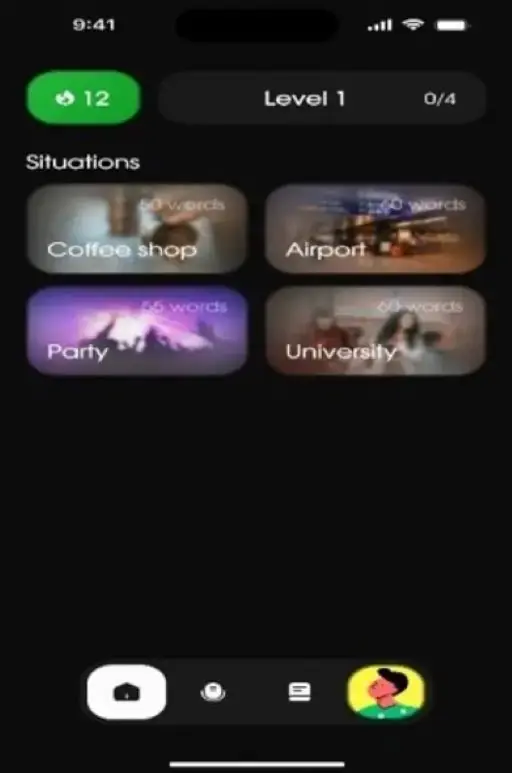
From here, the following functions appeared:
- Free Talk: Free conversations in which the user chooses topics. And the dialogue is created by artificial intelligence directly during the conversation. During the development of the program, this function was new. That is, we did not find the use of neural networks for dialogues in any of the studied applications. We put this function in first place, since it develops two skills: speaking and listening.
- Thematic Dialogues: Pre-created communication structures, each with a specific topic. Here, communication takes place in writing, where literacy, speed, and correctness of the answer are taken into account.
- Flash Cards: A set of words for expanding the vocabulary. They can also be adjusted by the number of additions, frequency of checks, and thematic focus. Additionally, the possibility of replacement after the user can correctly translate the word a certain number of times.
- Lastly, a significant detail that we learned from our research is to check your level. Namely, at certain intervals, the user undergoes complex testing to find out how his level has changed relative to the initial and previous ones.
Application “Hey!” – Main Characteristics and Possibilities
After analyzing existing applications for online English language learning, we were able to create our digital tool. Taking into account the following criteria:
- Functionality: This criterion reveals all the possibilities of the application. The more of them, the higher the potential of the application. But a mobile application overloaded with functionality may not appeal to users. Because of the need to spend a long time figuring it out and searching for the necessary information.
- Design: People do not perceive slow and overloaded complex design programs well. Users do not want to wait for the data to fully load, and also waste time on a lengthy study of navigation through sections. According to this criterion, the application should provide a comfortable user interface and intuitive interaction with the user. This criterion evaluates design, navigation, and notifications.
- Availability of Use: Applications must be accessible for all popular mobile devices and platforms on which they are based.
- Interface: This criterion is responsible for the ease of use of the application. Users find the application more comfortable and pleasant to use when designers optimize icon and button sizes, place the menu conveniently, and choose effective color and information accents.
- Offline Access: The ability to use the application without an Internet connection. This function is very useful and practical, as it will allow you to save mobile traffic. Also, when you do not have Internet access, you will be able to use the application without any problems.
Goal Achieved
During the research project, we developed a language learning mobile application of a certain specificity. Namely, we had a large-scale goal to create a mobile application that would allow the user to improve their language skills from any level to a level of comfort in the English-speaking environment.
So the main idea behind this app was that a person will remember and start using a foreign language much faster. If they find themselves in typical social situations, as if they were already in an English-speaking country.
The app is now available on Google Play. We have already registered the copyright for it and continue to develop it.
Functionality of the Application
The mobile application “Hey!” is intended for use in the field of education, in particular for independent and distance learning of English. The product is used in informal learning, language practice. Also, as an aid in preparing for exams (IELTS, TOEFL, etc.), professional retraining, adaptation to the English-speaking environment, and everyday language practice.
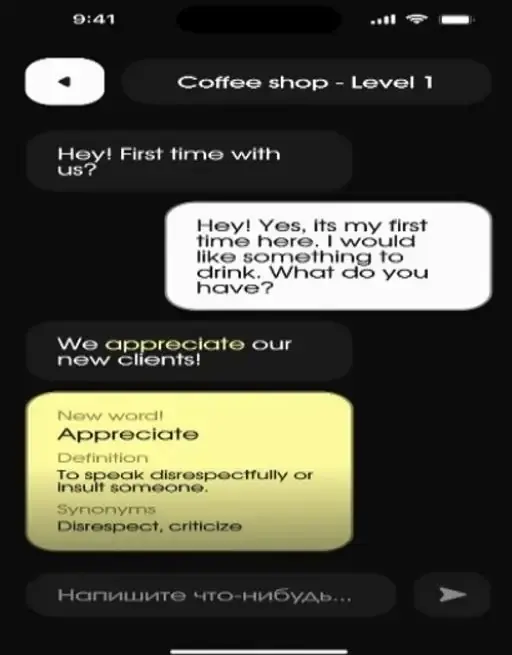
Programming Languages
We developed this application based on standard requirements for similar training systems. Further, updating them with the use of artificial intelligence resources, code.ai, recraft.ai, and openai. We created the application in the Godot game engine, using the GDScript programming language as the main development language.
Additionally, we used:
- GD Script: Built-in Godot programming language based on C++.
- JSON: for storing configurations, dialogs, and user data.
- The interface design was developed in the Figma graphic editor.
Functional Capabilities
The application provides for the creation of an account for each user with the accumulation of information about personal learning dynamics. This allows determine the user’s starting level of English. For each level, the system selects a training program (a corresponding set of dialogues) based not only on the client’s knowledge but also on their preferences for timing, such as reading, dialogue, listening comprehension, and vocabulary. During the training process, a person will be able to monitor the dynamics of their training, comparing the current level with the initial one. Complex testing can determine the parameters for level assessments. Additionally, evaluators consider the percentage of material covered from the total initially planned training volume as a supplementary indicator.
In parallel with language learning, our users will be able to virtually immerse themselves in the environment, becoming part of an English-speaking society. Some exercises involve artificial intelligence. This makes it possible not only to practice language skills and pronunciation, but also to completely simulate a situation (stadium, museum, college, cafe, metro, etc.) Hence, so that a person feels part of that language environment. At the same time, the necessary set of words is selected (the learner can regulate the speed of conversation independently).
Additional Functions
In the future, we will provide the possibility of dialogues that preserve the accent of the desired country. All these factors bring the dialogue with the device as close as possible to a conversation with a native speaker. Immersion in the language environment with the simulation of situations allows not only to improve speaking skills and increase vocabulary but also to expand knowledge about the culture of other countries. Thus, to feel the behavior model of people there. And this part of our application is still a rarity in relation to existing training programs, which gives it special value with the open access of our software product “Hey!”.
The user can select situational dialogues based on their preferences and aspirations. If the topic holds no particular importance to them, the application randomly selects from the incomplete ones. The application independently determines whether the dialogue is complete, using indicators defined by the developers. It evaluates the conversation based on the number of syntactic and phonetic errors.
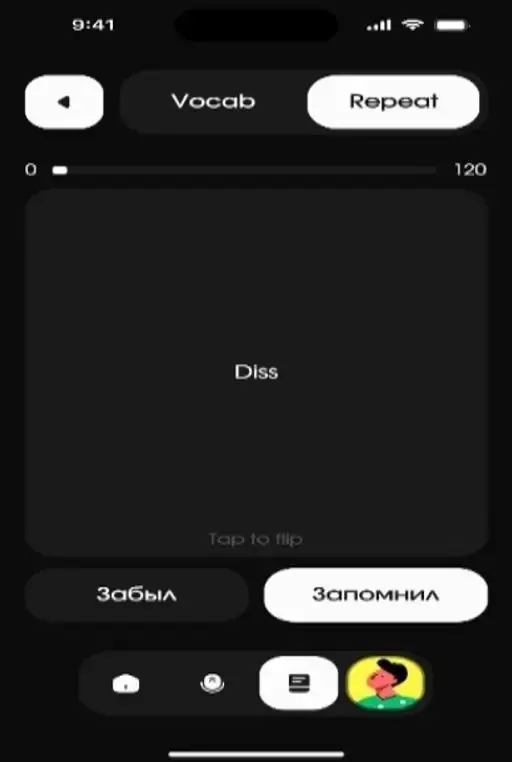
Flash Cards
To build vocabulary, a system of flash cards is provided, which will allow you to study new words and set phrases. Also, add them and repeat them in random order. Let us explain, there are two types of flash cards: the first is words and phrasal verbs; the second is various set phrases used in everyday life. Additionally, phraseological units have a certain figurative meaning.
And another important function of our program is Free Talk, dialogues on a free topic. In them, artificial intelligence also acts as a partner. Here, a full set of words and grammatical constructions is used that the student should know at the moment.
Users can conduct such a dialogue in various modes—for example, with English subtitles. They can also adjust the dialogue speed based on their training level or at the user’s discretion.
Main Technical Characteristics
- Software Product Size: Approximately 120–150 MB (depending on platform and included content).
- Durability of Hardware and Software:
- The application is crash-resistant, and progress is saved automatically and regularly.
- An error handling system is used to prevent loss of user data.
- You can operate the application in offline mode; however, it loses the Free Talk dialog function in this case, as neural networks generate those dialogs.
- The program has been tested on various models of mobile devices.
Minimum Device Requirements :
- Operating System: Android 8.0+ / iOS 13.0 +.
- Processor: dual-core, with a clock frequency of 1.5 GHz.
- RAM: from 2 GB.
- Free Space: at least 200 MB.
- Required Components: microphone, speaker/headphones, internet access (for online functions).
So, to briefly summarize all of the above, we can say that the “Hey!” application is an innovative educational platform for learning English. That combines advanced technologies and unique methods. Users can create personal accounts that provide access to educational materials from anywhere in the world and allow them to track their progress. The application offers adaptive learning programs based on the individual level of knowledge of the user and their personal preferences. This makes the process as effective and individualized as possible.
One of the key features is the ability to fully immerse yourself in the language environment with the help of artificial intelligence. Thus, it simulates various life situations, creating a feeling of real communication with a native speaker. The application also offers a variety of dialogues on selected topics, a flashcard system for expanding vocabulary. And a free conversation function, where the user can improve their skills in real conditions. These unique features make the application an indispensable tool. For those who seek not only to learn English but also to immerse themselves deeper into the cultural context of English-speaking countries.
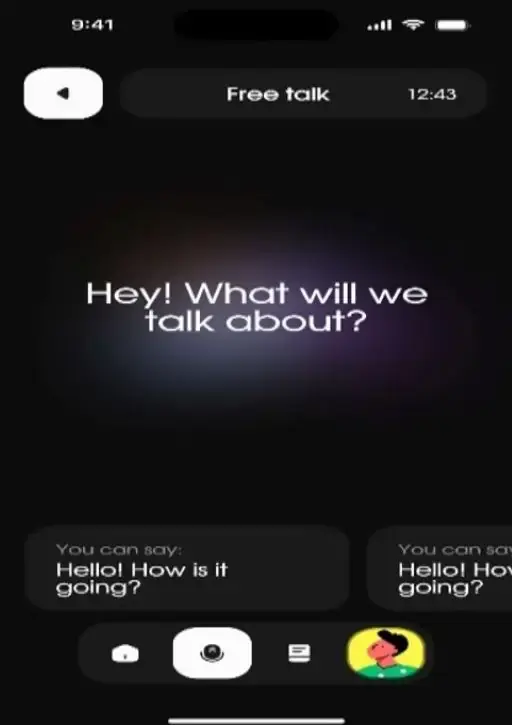
Project Development
At this level, we do not plan to stop our project; on the contrary, additional ideas for upgrading the application have now emerged:
- We will develop libraries of thematic conversations and dialogues, Free Talk.
- We will add a database of typical speech patterns, knowledge of which will facilitate conversation and understanding.
- We will add tests to assess the client’s language level.
- Add a multiplayer feature that lets you talk to real people, the same clients who are open to dialogue and marked with a special sign.
- Create a module that not only records syntactic or phonetic errors, but also provides detailed comments: points out specific problematic sounds, compares the user’s pronunciation with the reference (native speaker), and offers exercises for correction. Such technologies (for example, those used in the Elsa application Speak ) will help users improve their accent and fluency to a whole new level.
In addition:
- We will build algorithms into the program to analyze the topics that the user most often chooses and automatically offer new dialogues or cards that match their interests (for example, sports, culture, business, science). This will increase motivation, because learning will become not only useful, but also personally exciting.
- To increase user engagement, we will build in a system of achievements, ratings, collectible badges, and progress bars. For example, a user receives virtual awards for a 7-day series of lessons, for completing thematic blocks, or for completing special tasks. Duolingo and other popular platforms successfully use this element to retain users’ attention over the long term.
- Create sets of scenarios that reflect the specifics of regional English (e.g., American, British, Australian, Indian variants), including typical phrases, idioms, and accents. This will not only help to better understand different variants of the language, but also prepare users for real situations of communication with people from different countries. For example, this is especially useful for corporate clients to prepare for international negotiations.
Conclusion
Thus, the mobile application “Hey!” represents for us an important experience in the field of creating a modern digital product, combining advanced technologies and taking into account the real needs of users. We hope that the created application will be interesting and useful for both students and teachers, as well as for everyone who wants to learn English quickly, deeply, and with pleasure.
Hey! – app on Google Play, Golendukhin, Yaroslav, and Saveliy Varlamov. 2025. Note: Yaroslav Golendukhin and Saveliy Varlamov, 10th grade students of BEST Gymnasium (Petropavlovsk, Kazakhstan), developed this app under the guidance of their English teachers, Yulia Dmitrieva and Yulia Starchekova.
Additionally, to stay updated with the latest developments in STEM research, visit ENTECH Online. Basically, this is our digital magazine for science, technology, engineering, and mathematics. Furthermore, at ENTECH Online, you’ll find a wealth of information.
